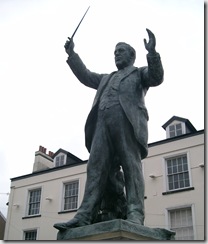[this is a version of a post which first appeared on my blog From the Front of the Choir]
Sometimes I describe my job as being the guy who stands out front and waves his arms about. “I point, you sing” is what I tell the choir.

That is basically what the job entails when the choir performs, but it can all too easily go wrong.
There have been times in concert when I have made gestures which have been totally misinterpreted.
Once I gestured for the choir to sing more quietly and suddenly only one part was left singing. Sometimes I’ve looked askance at a section and they’ve all got louder for no reason. When I’ve wanted the choir to repeat a section, they simply go faster.
We’ve not been speaking the same language.
The choir usually manage to recover, and I’m sure the audience don’t notice anything amiss, but it does remind me how important it is that the choir know exactly what I mean at any point.
Even if you think a gesture is screamingly obvious, you can never, ever assume that all your singers will understand it in the same way.
I was once ‘talking’ to a profoundly deaf person by gesturing in what I thought was a clear and unambiguous way. She didn’t understand a single thing! We ended up writing to each other on the tablecloth.
Sometimes after a whole bunch of new people have joined the choir, I run through some of my basic hand gestures and tell them what they mean. Disturbingly sometimes a satisfied “Ah!” goes up from the rest of the choir as the penny drops. Which makes me realise that they, too, may need a regular refresher.
When I first began conducting choirs, I thought that all my gestures were self-evident and that most conductors use similar hand movements. How wrong I was! So since then I have regularly double-checked that the choir know what I intend.
As choral directors, we all do things differently, but the common point is that we need to be clearly understood by our own choir.
I use one gesture which I have been told is a real no-no, but which seems to work for me and the choirs that I lead. It is to raise my two index fingers vertically (as if pointing to the sky) which is a signal that something is about to happen. It’s a kind of “heads up” to people that they should pay attention because we’ll be doing something significant in a moment like coming to the end of the song, or repeating the last section, or speeding up.
I have been told that this gesture is too subtle and vague to be useful. However I find it to be very effective, but only after you have rehearsed the song properly so that the choir know what to expect.
It means that I can often dispense with counting in a performance (“how many times do we repeat that section?”) so everyone can really be in the moment, repeating parts as many times as it feels right to do them in any given concert.
I now realise that when I began this work I used to assume quite a lot. Now I work very hard to try and be aware of when I’m making assumptions.
For example, when I’m teaching a song by ear I signal where the tune goes up and down by raising and lowering my horizontal hand. This is just a rough map of course, but it helps people when they’re learning. I can be slightly more subtle too by indicating big jumps in notes, and sometimes angling my hand slightly to indicate semi-tones.
Once I was running a workshop and a French guy asked my why I was moving my hand up and down in the air whilst teaching the song. I explained that as my hand moved higher it meant the notes were higher, and when I moved it lower it meant that the notes were lower.
Then he asked what “higher” and “lower” meant! It was then that I realised that this is not innate knowledge but just a convention. If someone is familiar with a piano, then we could equally well describe notes as being more “left” or more “right”.
It has become a convention (related to sound frequency) to talk about “higher” and “lower”, but we cannot assume that everyone knows what this means!
There ARE no universal gestures or “industry standards”. What you think might be clear and obvious and widely understood might be a complete mystery to some singers.
Not all choirs need the same set of hand gestures. If your choir is regularly speeding up, then maybe you need to invent a gesture which means “Whoa! Slow down”. The gesture of raising my two index fingers (as outlined above) may only make sense to the choirs that I run.
Why not try swapping conductors with another choir for one session and see how many of their gestures are obvious?
It’s good to re-assess every now and then and to make sure that you are communicating with your choir members as clearly and accurately as you can.
Do not assume that they always know what you mean!
Chris Rowbury
website: chrisrowbury.com
blog: blog.chrisrowbury.com
Facebook: Facebook.com/ChrisRowbury
Twitter: Twitter.com/ChrisRowbury